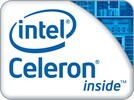Intel Celeron 1007U vs Intel Celeron 1020M
Intel Celeron 1007U
► remove from comparison
Der Intel Celeron 1007U ist ein sparsamer Doppelkernprozessor aus dem Einstiegssegment. Er taktet mit 1,5 GHz und basiert auf der Ivy Bridge Architektur. Im Vergleich zu den Core-i3-, i5- und i7-Prozessoren sind jedoch die meisten Features deaktiviert (Turbo Boost, AES, HyperThreading). Die integrierte Grafikkarte basiert auf der HD Graphics 2500, wird jedoch von Intel nur HD Graphics genannt und mit 350 bzw. 1000 MHz (Turbo Boost) getaktet. Ausserdem ist ein DDR3-1600-Speicherkontroller in dem Prozessor integriert.
Die Performance liegt dank der verbesserten Architektur etwas oberhalb einer ähnlich getakteten Sandy-Bridge-CPU und somit knapp unter dem Level eines Intel Celeron B820.
Die Ivy Bridge Prozessoren beinhalten in der angegebenen TDP auch die Grafikkarte und den Speicherkontroller. Mit 17 Watt TDP eignet sich der Prozessor für kleine Notebooks und Subnotebooks.
Intel Celeron 1020M
► remove from comparisonDer Intel Celeron 1020M ist ein Doppelkernprozessor aus dem Einstiegssegment. Er taktet mit 2,1 GHz und basiert auf der Ivy Bridge Architektur. Im Vergleich zu den Core-i3-, i5- und i7-Prozessoren sind jedoch die meisten Features deaktiviert (Turbo Boost, AES, HyperThreading). Die integrierte Grafikkarte basiert auf der HD Graphics 2500, wird jedoch von Intel nur HD Graphics genannt und mit 650 bzw. 1000 MHz (Turbo Boost) getaktet. Ausserdem ist ein DDR3-1600-Speicherkontroller in dem Prozessor integriert.
Die Performance liegt dank der verbesserten Architektur etwas oberhalb einer ähnlich getakteten Sandy-Bridge-CPU und somit etwa auf dem Level eines Intel Pentium B960.
Die Ivy Bridge Prozessoren beinhalten in der angegebenen TDP auch die Grafikkarte und den Speicherkontroller. Mit 35 Watt TDP eignet sich der Prozessor für Notebooks ab etwa 13 Zoll.
| Model | Intel Celeron 1007U | Intel Celeron 1020M | ||||||||||||||||||||||||||||||||||||||||||||||||||||||||||||||||||||||||||||||||
| Series | Intel Celeron | Intel Celeron | ||||||||||||||||||||||||||||||||||||||||||||||||||||||||||||||||||||||||||||||||
| Codename | Ivy Bridge | Ivy Bridge | ||||||||||||||||||||||||||||||||||||||||||||||||||||||||||||||||||||||||||||||||
| Serie: Celeron Ivy Bridge |
|
| ||||||||||||||||||||||||||||||||||||||||||||||||||||||||||||||||||||||||||||||||
| Clock | 1500 MHz | 2100 MHz | ||||||||||||||||||||||||||||||||||||||||||||||||||||||||||||||||||||||||||||||||
| L1 Cache | 128 KB | 128 KB | ||||||||||||||||||||||||||||||||||||||||||||||||||||||||||||||||||||||||||||||||
| L2 Cache | 512 KB | 512 KB | ||||||||||||||||||||||||||||||||||||||||||||||||||||||||||||||||||||||||||||||||
| L3 Cache | 2 MB | 2 MB | ||||||||||||||||||||||||||||||||||||||||||||||||||||||||||||||||||||||||||||||||
| Cores / Threads | 2 / 2 | 2 / 2 | ||||||||||||||||||||||||||||||||||||||||||||||||||||||||||||||||||||||||||||||||
| TDP | 17 Watt | 35 Watt | ||||||||||||||||||||||||||||||||||||||||||||||||||||||||||||||||||||||||||||||||
| Technology | 22 nm | 22 nm | ||||||||||||||||||||||||||||||||||||||||||||||||||||||||||||||||||||||||||||||||
| Die Size | 94 mm2 | 94 mm2 | ||||||||||||||||||||||||||||||||||||||||||||||||||||||||||||||||||||||||||||||||
| max. Temp. | 105 °C | 105 °C | ||||||||||||||||||||||||||||||||||||||||||||||||||||||||||||||||||||||||||||||||
| Socket | FCBGA1023 | rPGA988B | ||||||||||||||||||||||||||||||||||||||||||||||||||||||||||||||||||||||||||||||||
| Features | HD Graphics (350 - 1000 MHz), DDR3 Memory Controller, Enhanced Speedstep, Thermal Monitoring, Execute Disable Bit | HD Graphics (650 - 1000 MHz), DDR3 Memory Controller, Enhanced Speedstep, Thermal Monitoring, Execute Disable Bit | ||||||||||||||||||||||||||||||||||||||||||||||||||||||||||||||||||||||||||||||||
| iGPU | Intel HD Graphics (Ivy Bridge) (350 - 1000 MHz) | Intel HD Graphics (Ivy Bridge) (650 - 1000 MHz) | ||||||||||||||||||||||||||||||||||||||||||||||||||||||||||||||||||||||||||||||||
| Architecture | x86 | x86 | ||||||||||||||||||||||||||||||||||||||||||||||||||||||||||||||||||||||||||||||||
| $86 U.S. | $86 U.S. | |||||||||||||||||||||||||||||||||||||||||||||||||||||||||||||||||||||||||||||||||
| Announced | ||||||||||||||||||||||||||||||||||||||||||||||||||||||||||||||||||||||||||||||||||
| Manufacturer | ark.intel.com | ark.intel.com |


 Deutsch
Deutsch English
English Español
Español Français
Français Italiano
Italiano Nederlands
Nederlands Polski
Polski Português
Português Русский
Русский Türkçe
Türkçe Svenska
Svenska Chinese
Chinese Magyar
Magyar
